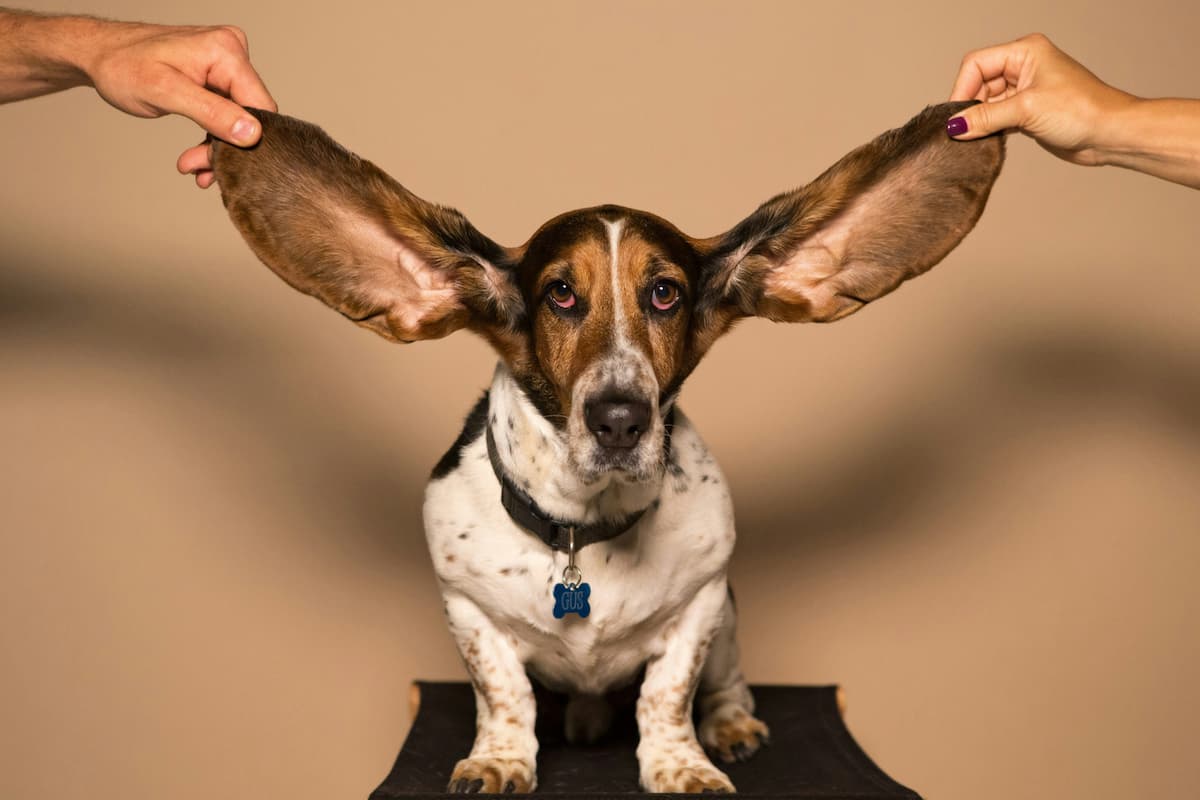Picture this: a beautiful sunny day at the park as your furry friend joyfully interacts with their fellow canine pals.
Tails wagging, tongues lolling, and playful barks filling the air.
But suddenly, a peculiar scene unfolds before you – a dog gently sinking their teeth into another dog’s ear!
A mixture of concern and curiosity takes hold, prompting the question to arise: Why do dogs bite each other’s ears anyway?
Read to have your question answered.
Why is Ear Biting Common Among Dogs?
Ear biting may seem like a strange behavior, but it is actually quite common among dogs.
Dogs use various forms of communication with one another, and biting each other’s ears is just one way they interact.
Here are some reasons why our furry friends engage in this seemingly odd habit.
1. Establishing Dominance
When dogs engage in ear biting, it can be a way for them to assert dominance over one another.
Dogs have an instinctual need to establish a hierarchy within their pack, and biting each other’s ears can be one way to determine who is in charge.
By targeting the ears, which are sensitive and can cause discomfort, dogs can send a clear message to their playmate that they are in control.
2. Playful Interaction
While ear biting can sometimes appear aggressive, it’s important to remember that many dogs use it as a form of playful interaction.
Play fighting is a common behavior observed among dogs, and ear biting is often a part of this play.
It can be a way for dogs to engage in a friendly competition, hone their hunting skills, and even strengthen their bond with one another.
As long as both dogs are enjoying the interaction and showing no signs of distress, there is usually no cause for concern.
3. Communication and Socialization
In addition to dominance and play, dogs also use ear biting as a means of communication and socialization.
When one dog bites another dog’s ears during play, they may be trying to convey a specific message.
It could be a signal to initiate or end the play session, establish boundaries, or even seek attention.
By observing their body language and overall interaction, we can gain valuable insights into the complex ways dogs communicate with one another.
4. Exploring Through Senses
Dogs have an incredible sense of smell, and their ears play a vital role in gathering information about their surroundings.
By biting each other’s ears, dogs can get a closer sniff, helping them learn more about their canine companions.
It’s like they are saying, “Hey, let me get a whiff of who you are!”
5. Motherly Instincts
Puppies often bite their mother’s ears during nursing to stimulate milk flow.
This behavior can carry over into adulthood, where dogs may instinctually bite each other’s ears as a way to seek attention or express their need for nurture.
Signs and Reasons When Ear Biting Becomes Aggressive
Dogs are known for their playful nature, and it’s not uncommon to see them engage in friendly wrestling matches with their furry friends.
However, sometimes these games can escalate, and ear biting becomes aggressive.
This behavior can be concerning for pet owners, but understanding the signs and reasons behind it can help you address the issue effectively.
Here are some signs that indicate ear biting has become aggressive:
1. Growling and snarling: When dogs engage in aggressive ear biting, they often accompany it with growling or snarling.
This is a clear indication that they are feeling threatened or trying to assert dominance.
2. Prolonged biting: Playful biting usually involves quick snaps or gentle mouthing.
Aggressive ear biting, on the other hand, is characterized by more forceful and persistent biting.
If the biting continues after the recipient has shown signs of discomfort or fear, it is likely that the situation has escalated.
3. Body language: Dogs communicate through body language, and paying attention to their cues can provide valuable insights.
Signs of aggression while ear biting can include raised hackles, stiff body posture, staring, and showing teeth.
Understanding the reasons behind dogs biting each other’s ears can help prevent or address the issue.
Here are some common motivations behind this behavior:
1. Dominance: Dogs, being pack animals, have a natural instinct to establish and maintain their position within a hierarchy.
Aggressive ear biting can be a display of dominance or an attempt to assert control over another dog.
2. Fear or anxiety: Dogs may resort to aggressive ear biting if they feel threatened or fearful.
It can be their way of defending themselves or trying to establish boundaries when they are uncomfortable.
3. Lack of socialization: Proper socialization during puppyhood plays a crucial role in a dog’s behavior as an adult.
If a dog hasn’t had positive experiences interacting with other dogs during this critical phase, they may be more prone to exhibit aggressive behaviors like ear biting.
In conclusion, while it’s important to allow dogs to engage in healthy play and interaction, it’s equally important to recognize when ear biting becomes aggressive.
By being aware of the signs and reasons behind this behavior, you can take appropriate steps to address the issue and ensure the safety and well-being of all dogs involved.
How to Discourage Inappropriate Ear Biting
While ear biting may be a natural behavior for dogs, it can sometimes become inappropriate or excessive.
So, how can we discourage this behavior?
Redirect their attention: If you notice your dog attempting to bite another dog’s ears, quickly redirect their attention to a more appropriate toy or activity.
Provide them with plenty of chew toys and interactive playtime to engage their energy in a positive way.
Positive reinforcement: When your dog chooses not to bite another dog’s ears, praise and reward them for their good behavior.
Positive reinforcement can go a long way in reinforcing desired actions, and your dog will learn that alternative behaviors lead to rewards.
Consistent training: Training your dog to respond to commands like “leave it” or “no bite” can help deter them from engaging in ear biting.
Use consistent and gentle training techniques to set clear boundaries and encourage appropriate behavior.
Remember, every dog is unique, and what works for one may not work for another.
If you’re having trouble discouraging inappropriate ear biting in your dog, consider seeking guidance from a professional dog trainer or behaviorist.
With patience and perseverance, you can help your furry friend understand that there are more appropriate ways to interact with their canine companions.
Effective Training Techniques to Promote Safe Social Interaction
Remember, it’s important to always supervise dog playtime and make sure it remains safe and positive.
If you notice one dog becoming overly aggressive or causing harm during ear biting, it may be necessary to intervene and redirect their behavior.
Providing effective training techniques like proper socialization, reward-based training, and teaching appropriate play behavior can help promote safe social interaction among dogs.
In conclusion, dogs biting each other’s ears is a complex behavior with various motivations.
While it can be a playful gesture or a dominance display, it can also serve as a way for dogs to set boundaries.
Understanding the different factors that contribute to ear biting can help dog owners create a safe and harmonious environment for their furry companions.
So, the next time you witness this behavior, remember that it’s a part of their natural communication and interaction process.
FAQ
Q: So, why on earth do dogs find ears so intriguing?
A: You see, for our canine companions, communication is not all about barking and wagging tails.
Their body language plays a significant role too, and ears are like a secret language for our furry friends.
Q: Can you elaborate on that?
A: Absolutely!
Dogs use their ears much like we use our facial expressions.
They have a fantastic ability to communicate their feelings through subtle movements and positions of their ears.
Now, when one dog decides to nibble on another dog’s ear, it’s like they’re quietly saying, ”Hey pal, let’s play” or “Please stop, you’re annoying me!”
Q: So, is ear-biting always a playful act?
A: Not necessarily.
Sometimes, dogs bite ears during playtime as a sign of excitement and engagement.
However, in some cases, it might also indicate dominance or a mild scuffle between furry playmates.
It’s like a way for them to establish their social hierarchy without causing any real harm.
Q: Is ear-biting ever a cause for concern?
A: Usually, it’s harmless and nothing to worry about.
Dogs have relatively tough ears, and their bites are rarely severe.
However, if you notice signs of aggression or discomfort, like growling, snapping, or excessive force, it’s best to intervene and separate them, ensuring everyone’s safety.
Q: Are there any breeds more prone to ear-biting?
A: Not necessarily.
Ear-biting can happen among dogs of any breed or mix.
It’s more about individual behavior and personality rather than breed predisposition.
Just like humans, dogs have their own unique quirks!
Q: How can we determine if our dog enjoys or dislikes having their ears nibbled?
A: Ah, reading your pup’s body language is key here.
If your dog willingly engages in ear-biting with their playmates and seems relaxed, it’s likely they find it enjoyable.
On the other hand, signs of anxiety, discomfort, or attempts to avoid ear-biting may indicate they’re not fans of this playful gesture.
Q: Is there anything we can do to discourage or redirect ear-biting behavior?
A: Well, redirecting is always a helpful technique!
Offering toys or engaging in interactive games can help redirect their attention from nibbling on ears to more acceptable forms of play.
Additionally, providing proper socialization and training from an early age can help dogs understand boundaries and appropriate behavior during playtime.
After all, a wagging tail and a pair of furry ears are some of the many joys our four-legged companions bring into our lives!
Parting Words
Ear biting may seem strange to us humans, but for our furry companions, it’s an instinctual behavior rooted in their evolutionary history and social dynamics.
From playfulness to communication, dogs have discovered a whole range of reasons to engage in this peculiar ear-biting ritual.
So, the next time you see two dogs entangled in an ear-biting frenzy at the park, remember that it’s just their way of expressing themselves and strengthening their bond.
While it might look aggressive to us, it’s often innocent and harmless, an essential part of their doggie interactions.
As responsible pet owners, let’s continue to observe our furry friends, learn how they communicate with each other, and ensure their safety and well-being during their playful escapades.
And who knows, they might even teach us a thing or two about the importance of some good old-fashioned ear nibbling in our own social dynamics!














